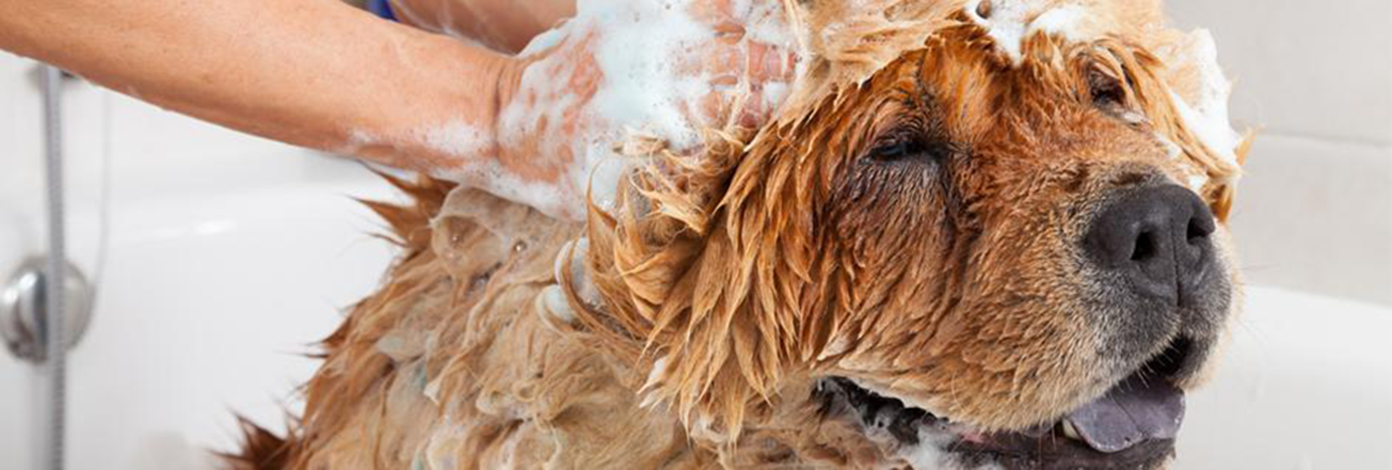How to bathe and clean your dog

Published April 2022
Bathing your pooch doesn’t have to be a difficult task. As long as you use the right products and make sure your dog is feeling comfortable, washing them should be easy. However, some dogs might find bath time a bit stressful. Signs of distress typically include changes in body posture, shaking, whining, barking, or panting. If your dog shows any signs of these don’t force them into bath time.
Here’s everything you need to know about how to properly bathe and clean your dog plus a few dog grooming tips.
Where should you bathe your dog?
Depending on the size of your pet, the sink or bathtub will be fine. Choosing the right place depends entirely on their size and your facilities.
You may even be able to bathe your dog outside if the weather is warm enough. Plus, a dog shower is great for those pups who might not be huge fans of bath time.
Older dogs may also benefit from a shower as they’re less likely to jump out and injure themselves. A shower is also good for older dogs because they may tire easily from standing in the bath. If you’re a little short for time, controlling the water flow with a handheld showerhead can be more efficient than bathing your dog using a tap.
However, if your shower is too small for this or you’re looking for a more flexible and stress-free option, try using a small dog bath or a medium dog bath. With most dog baths, there’s nothing to assemble, it’s durable and includes a leash retainer to keep your dog from going anywhere.
Brush your dog before washing them
If your dog is a longer-haired breed, make sure to brush through their fur before you put any product or water on it. This avoids matting their fur, which could hurt your pet when brushing. If you’re looking to improve their coat’s appearance, using a 2-in-1 brush lets you de-tangle your pet’s fur and adds shine at the same time.
If your dog has matted hair, you may want to avoid bathing them until you’ve removed it. Brushing your dog not only makes their fur look and feel smoother, but also makes it easier to wash.
What should the water temperature be?
Bathe your dog like you would an infant. Use lukewarm water as hot water can burn their skin. Larger dogs need cooler water as they tend to overheat more than smaller dogs.
Dog shampoo
Dogs should be bathed and washed using a shampoo specifically made for dogs. However, there are a few things you should take into consideration when buying shampoo. If your dog has sensitive skin, you’ll need to use hypoallergenic doggy shampoo. Or if you have a puppy, you’ll need a specific shampoo for pups. Short haired dogs tend to benefit from a gentler shampoo and conditioner.
It’s also best to research into the doggy shampoos that are available, and see which is most suitable.
Make sure you use a shampoo that’s made specifically for dogs. The best ingredients to look for are natural ones, such as aloe vera and oatmeal. Always read the label too as shampoos that contain artificial fragrances should be avoided. Never use shampoos designed for humans, as this can cause skin irritation and brittle fur.
Make sure your dog’s fur has no shampoo left in it before ending the bath. If you’re looking to keep your dog fresh between baths, dry shampoo for dogs is a great alternative. Also known as waterless shampoo, it keeps your dog’s skin and coat healthy until its grooming day.
How often can you bathe a dog?
This depends on your dog’s fur. Most dogs don’t need to be bathed any more than once a week and many may need much less.
You should be careful not to bathe your pooch too much. Over-cleaning can strip your dog’s fur of its natural oils and make them prone to dandruff, matting and frizz. Most short-haired dogs only need monthly baths.
How should you bathe your dog?
Once you put your dog in the bath, make sure there is only enough water to cover the bottom of the bath. A dog’s bathing experience is very different to our idea of a relaxing bath-time!
When bathing your pet, try to keep their eyes and ears dry. This may help them feel more comfortable. Also, water in the eyes or ears could cause an infection.
You can use a towel to dry off the excess water after your dog’s bath, but you should let your dog’s fur dry naturally as this allows their skin to breathe. Avoid using a hairdryer as this could burn them. Make sure your pooch is comfortable while you’re bathing them. If your dog doesn’t enjoy bath time, you should always reward them with a treat at the end of the wash as positive reinforcement.
Don’t forget to insure your dog. This can help pay for the treatment they need if they fall ill. You’ll find lots of handy advice at Sainsbury’s Bank Pet Insurance.
This Money Talk post aims to be informative and engaging. Though it may include tips and information, it does not constitute advice and should not be used as a basis for any financial decisions. Sainsbury's Bank accepts no responsibility for the opinions and views of external contributors and the content of external websites included within this post. Some links may take you to another Sainsbury's Bank page. All information in this post was correct at date of publication.
